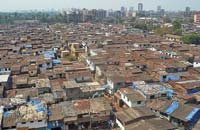
Mumbai is at the forefront of a new tourism trend seeking to make the most of the one commodity it has more than enough of: its poor.
In a trend also taking off in South Africa, Brazil and Mexico, at least one tour operator is now offering tours are now offering trips through Dharavi, which has the rather dubious distinction of being Asia’s biggest slum, a piece of land 175 hectares large bang in the centre of the city.
Reality Tours and Travel says on its website that Dharavi is one of the most interesting places to see in Mumbai, and that while it isn’t dangerous to visit alone, its beauty lies not on the main roads but “in the small hidden alleys where thousands work and live in a number of small enterprises, where goats roam freely, and where children play with carefree abandon”.
The tour is reportedly set to make it into the next edition of the Lonely Planet guide to India. Prices begin from Rs300 ($7.5) per head for a two and half hour tour and stretch to Rs2400 ($60) for a private four and half hour tour for up to five people in an air conditioned car, with the city’s famous red light district and its open air laundry area at Dhoby Ghat thrown in.
With Dharavi generating an estimated $665 million annually, the tour takes in a wide range of the small-scale industries it is home to, including recycling, embroidery, baking, soap manufacturing, leather tanning, garment manufacturing and more.
Famous visitors in the past include the UK’s Prince Charles and former US president Bill Clinton.
“Fifty five percent of people in Mumbai live in slums,” British national Chris Way, who runs the firm, told MSNBC.com. “Through the tours you connect and realise that these people are the same as us.”
So much for those critics of poverty tourism, who point out that it exploits people and turns neighbourhoods into zoos.
Way runs the tours with the guides who speak the local languages and with co-operation from the residents. The firm’s site also takes pains to make clear it is not propagating profit at the cost of the disadvantaged. “We have started a Community/ Education Centre and 80 per cent of profits after tax from these tours are donated to local charities,” it says.
